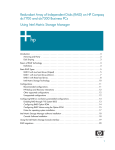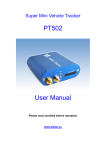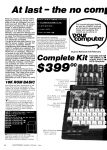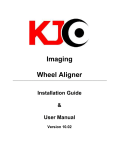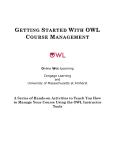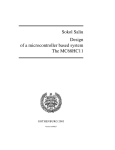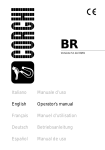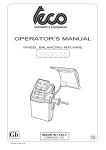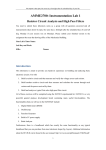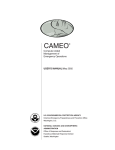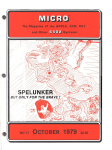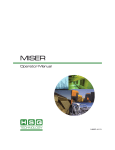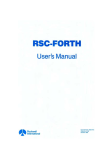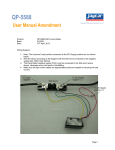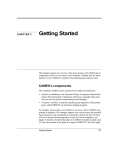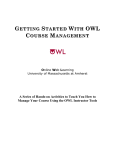Download Microprofessor - The MESSUI Place
Transcript
Electronics Australia reviews the Multitech MPF-III Personal Computer The MPF-III from Multitech is the latest development of the , Microprofessor series, expanded to a full disk-based computer system with video output. Two microprocessors are provided, the Z80 and 6502, to allow the MPF-III to run software intended for the CP/M system and the Apple II. Multitech has gone to a great deal of trouble to ensure that the standard operating system of the MPF-III is compatible with that of the Apple II without breaching Apple's copyright. Most of the system calls are preserved and all software we tested ran without problems. At the time of this review Apple's appeal against Computer Edge Pty Ltd is pending and we do not in fact know whether Apple's claim that their operating system is copyright will be successful. While the point is important to manufacturers offering other Apple "work-alikes", it will make no difference to the MPF-III, as Multitech had Apple's permission to produce a compatible operating system without actually copying the code in dispute. While the MPF-III may use a 6502 it physically in no way resembles the Apple II. The actual computer is in two parts, a detachable low-profile keyboard and a "system unit" which contains the dual processors, control logic and 64K of programmable memory. Two half-height 14cm minifloppy drives in a matching case rest on top of the system unit, and a 30cm green phosphor video monitor on a tilt and swivel stand complete the set up. A coiled, extensible cable connects the keyboard to the system unit via a 15-pin D-type connector plugged into the right side of the system unit while the disk drives are connected by a flat cable at the rear. The MPF-111 keyboard is in the latest "ergonomic" style, measuring just 18mrn high at the front by 400 x 178mm (W x D). Height at the rear is 34mm or 45mni when two small legs are used to tilt the keyboard. The key layout is dished, or slightly concave from back to front and 90 keys are provided, in buff and grey with black legends. In addition to 48 alphanumeric keys the MPF-111 provides 12 programmable function keys, a 14-key keypad with cursor control keys and its own Return key and 16 miscellaneous system control keys, including Caps and Number lock, Reset, Break and Halt. MPF-III Basic statements and functions ABS, AND, APPEND, ASC, ATN, BASS, BLOAD, BRUN, BSAVE, CALL, CATALOG, CHR$, CLEAR, CLOSE, COLOUR, CONT, COS, DATA, DEF FN, DEL, DELETE, DIM, DRAW, EFFECT, END, EXEC, EXP, FLASH, FOR . . . NEXT, FP, FRE, GET, GOSUB, GOTO, GR, HCOLOR, HGR, HGR2, HIMEM, HLIN, HOME, HPLOT, HTAB, IF . . . THEN, INIT, INPUT, INSTR, INT, INVERSE, IN# LEFT, LEN, LET, LIST, LOAD, LOCK, LOG, LOMEM, MAXFILES, MID$, MON, NEW, NOMON, NORMAL, NOT, NOTRACE, ON GOSUB, ON . . . GOTO, ON ERR GOTO, OPEN, OR, PDL, PEEK, PLAY, PLOT, POKE, POP, POS, POSITION, PRINT, PR#, READ, RECALL, REM, RENAME, RESTORE, RESUME, RETURN, R1GHT$, RND, ROT, RUN, SAVE, SCALE, SCRN, SGN, SHLOAD, SIN, SPC, SPEED, SCAR, STEP, STOP, STORE, STR$, TAB, TAN, TEMPO, TEXT, TRACE, UNLOCK, USR, VAL, VERIFY, VLIN, VTAB, WAIT, WRITE, XDRAW. 1 06 ELECTRONICS Australia, February, 1984 On the review machine the space bar seemed a little stiff in action, and in spite of its ergonomic design approach the keyboard places the left Shift key one key further to the left than normally expected, leading to some initial confusion. The same placement is used on the IBM PC keyboard, causing considerable controversy, but has been abandoned in favour of the more usual layout on the PC Junior. Single key entry of Basic commands is supported, using the ALT key in conjunction with alphanumeric keys. The front of the system unit is bare except for a ventilation grille and a small rectangular LED power-on indicator. At the rear is a socket for 240VAC power and a rocker-type power switch, an RF modulated TV signal output and separate composite video and external speaker outputs, a printer port, disk drive connectors and EAR and MIC sockets for a cassette recorder. A bus expansion port and a connector for a proportional joystick or paddle is available at the right side. Also at the rear is a four-way DIP configuration switch which wts the MPFIII for an 80-column text display, Epson or C-Itoh printer operation, RF television channel output, and operation with 64K or 48K RAM (to emulate the functioning of the language card). Only the composite video output can be used, as the modulated RF output is in NTSC format, unsuitable for connection to Australian television receivers. There is also no PAL colour display adapter available, so colour is not an option on the MPF-III. On the other hand the MPF-III provides some compensation. First of all the screen display is 24 lines of 40 characters each, in upper and lowercase. An 80-column mode is also available with its own 2k screen memory, either selected by a configuration switch or from software, duplicating the function of boards such as the Vision-80 for the Apple II. • MPF-111 comes in two parts: a low profile keyboard and a "system unit" which contains the dual processors, control logic and 66K of RAM. Thus the MPF-III provides both an Apple-compatible display and a standard 80 x 24 line format for CP/M programs. In both display modes a screen editor is available, allowing the user to move the cursor on the screen, re-type program lines and insert and delete characters. High and low resolution graphics are also available. Low resolution is 40 x 48 blocks and high resolution is 280 x 192 points. In both modes, four lines at the bottom of the screen can be reserved for text, although otherwise text and graphics cannot be mixed on the screen. Colour can be specified for graphics, but on monochrome monitor the result is to change the pattern of the character as individual bits are shifted left or right. The original Apple II produces colour according to the phase difference between the colour burst signal and the MPF-I11 specifications Processors RAM ROM Interfaces Disks . Keyboard Display . 6502 and Z80 . 66K including 2K buffer for 80-column display 24K Serial printer, cassette interface joystick interface, external expansion slot . . A maximum of two, single-sided single density, 140K each unformatted 90-key full-stroke IBM-style 24 lines, 40 or 80 columns text, upper and lower case 40 X 48 resolution and 280 X 192 resolution graphics, no colour adapter available. Three octave range, special effects and rhythm accompaniment Compatible with CP/M 2.2 (assuming availability in a compatible disk format). Compatible with Apple II operating system 161 page operation manual luminance signal so that the colour of any particular point depends on its exact position on the screen. Sound is provided by an AY-3-8910 generator chip. Six Basic commands are available to produce various special effects, including waveforms to simulate a piano, xylophone, organ and bell sounds and a percussion accompaniment which can be set for various rhythm patterns. Sound is produced through an internal speaker, although there is a connector at the rear for an external loudspeaker. Statements controlling the sound generator are SONG, BASS, TEMPO, INSTR, PLAY and EFFECT. SONG takes parameters specifying the pitch and duration of notes over a three octave range while BASS selects one of eight percussion accompaniments. TEMPO is specified in beats per minute from 16 different settings available and INSTR selects the "instrument" or sound waveform. The MPF-III comes with a floating-point Basic interpreter in 11K of ROM, a machine language monitor and a comprehensive driver for the Epson MX-80 and C-Itoh printers. Sound effects and the 80 x 24 display screen are also supported. When a disk drive is connected the MPF-III will automatically load a disk operating system on start-up, allowing immediate access to disk-based application programs. If a CP/M master disk is used to boot up the system, the Z80 processor will be switched in automatically and the screen will display the CP/M prompt. In conclusion At $699 for the system unit and keyboard, the MPF-III offers the ability to run software for two of the most widely used microcomputer operating systems, Apple DOS and CP/M. It is not really a beginner's system however, as the user is very much alone when it comes to obtaining software in the correct disk formats. The MPF-III operating manual lists the facilities available, and provides details of the hardware and memory arrangement, but must be supplemented by other material if the user is not already familiar with a similar computer. Against these disadvantages is the relatively low price and potentially vast software base. For an experienced computer user looking for a "compatible", the MPF-III has much to offer. Further information on the MPF-III and a range of other computer systems is available from Emona Computers Pty Ltd, PO Box K720 Haymarket, NSW, 2000. ELECTRONICS Australia, February, 1984 107 MPF-IP Micro-Professor development system The MPF-IP Micro-Professor is a product of the Multitech Industrial Corporation of Taiwan. The MPF-IP is a complete microprocessor system based on the Z-80. It comes with detailed instruction manuals and a full range of options and accessories. by FRANCO UBAUDI The Micro-Professor is not an evaluation kit. It is a multi-purpose product intended to satisfy the needs of Education, Control, Interfacing and Development. There are two models, the MPF-I and the MPF-IP. We reviewed the latter version. The MPF-IP is one neat board measuring 157 x 220mm which accommodates a Z-80 processor chip, two 2K RAMs, one 8K ROM, two I/O port ICs and 12 other ICs for such tasks as decoding. The board is fitted with a, 49-key keyboard with QWERTY layout and a 20-digit, 14-segment alphanumeric green vacuum fluorescent display. Also included on the board is a cassette interface for program storage and retrieval and a speaker is provided for system and programmer use. With the speaker, the user may generate programs for producing anything from alarm sounds through to music. The entire board assembly is enclosed in a plastic binder which can be opened and closed like a book. The unit is powered from a 9V DC plugpack. Battery back-up for the RAM is included to store programs when power is removed from the unit. Included with the basic MPF-IP are three softcover manuals. There is a 130-page User's manual, a Monitor Program Source Listing, and an Experiment Manual. The monitor program manual contains a listing of the monitor program in both Z-80 assembler mnemonics and Z-80 assembled hex code. Included in the monitor program is a full Two-Pass Assembler, a Line 92 ELECTRONICS Australia, April, 1985 Assembler and a Dissambler. The MPFIP also offers a long list of subroutines, 44 in all. What is a two pass assembler? It is itself a program which is used to convert other programs into machine code. The conversion process takes two steps or passes, hence the name. In the first pass the assembler produces a symbol table which contains all the labels and their corresponding values found in the program. In the second pass the assembler uses the symbol table to generate the actual machine code, or as it is sometimes called, the object code. Because the two-pass assembler generates a symbol table during execution, more memory is required to produce the machine code program than is actually required to store it. Therefore, in the situation when there is insufficient memory for the two-pass assembler to work a one-pass assembler may be used. With this assembler, as each program line is entered the line is also assembled. An advantage of this is that your program is also checked for instruction errors as you enter it. The function of the disassembler is simply to produce a mnemonic program from Z-80 hex machine code. It is a very useful tool for reading EPROM's. Useful Commands You can enter hex code directly by using the M command. The M command is simply a display and alter function for the contents of memory. Therefore, with this command you can enter a complete program or change only certain locations. An example of its use is, <M> = FBOO: 12 13 14, to insert 12 into the location FBOO, while 13 and 14 are placed into successive locations. The F command is used to insert data into a specified memory range. For example if you required the hex value 34 to be placed in every memory location from FC00 to FDOO, the F command will do the job. The command line to do it is <F > = FC00 FD00 34. Another command is the R command, to display and alter the contents of registers. The Z-80 has quite a lot of internal registers in comparison to other CPUs. Actually the Z-80 has 22 separate registers in all. The use of the R command is as follows, R (return) to display all registers. To display just the C register for example, the command R : C (return) is used. Next is the W command which is used for storing programs or data on tape. Its format is as follows: W <starting address > space <ending address> space <filename > (return). To retrieve data or programs from tape, the L command is used. Its format is L <filename > (return). The read program is stored into the same location in RAM as it originally occupied. As well, a checksum is performed by the MPF-IP. The operation of the checksum is as follows: when a program is originally stored, a checksum value is calculated and also stored on the tape. When the program is read back into the MPF-IP a checksum is again calculated by the system; if both checksums agree all is well, otherwise an error message is issued. A useful command for the inexperienced programmer is the J command. This command is used for the calculation of relative addresses for jump instructions. Another useful command is the I command, which is used for inserting data into memory. For example data 1 2 3 4 5 is inserted at location F800 The Micro-Professor is a single board system which comes complete with three manuals. as follows : < I > = FE00/ <I> =F800 1 2 3 4 5 Simple isn't it? But the value of the I command is in that the data is "inserted", hence any data already present is shifted into higher memory addresses rather than over written. A complementary command to the I command is the D command. This command is used to delete data from memory in much the same manner as the I command is used to insert data. Debugging To help the user debug programs, two commands are provided by the MPF-IP. The first is the B command which is used to set and clear breakpoints within a program. Note that only one breakpoint can be used at any time. The second debugging method is provided by the S command. With this command you can execute a program one instruction line at a time. Therefore each time you press the S key another instruction line is executed. MPF-IP Micro-Professor Text Editor To enter the editor you hold the E key down while pressing the control key, or control E for short. After typing control E, you will be prompted to enter a starting and ending address for the text buffer. The editor will now prompt you to start entering your program. To exit from the editor you just hit the return key twice. If you need to re-enter the text editor the R command can be used. With the R command you can re-edit a program that already exists in the text buffer. 'Therefore, when you use the E command to enter the editor the MPFIP automatically resets the text buffer pointer, which means any new program entered is written over the top of any old program. That's the difference betweeen the E and R editor entry commands. To exit from the editor to the monitor the Q command is used. There are many other commands available for the editor, however to save space they will only briefly be mentioned in point form. * To insert lines when in the editor there is an I command. * To delete a line the D command is available. * To display n number of lines in the file from the current line use P n command. * To display all lines in a file the Z command is used. * To move the cursor to the bottom of a file use the B command. * To move the line pointer down to the nth line in the file use the G n command. * To move the line pointer up n lines use the U n command. * To move the line pointer down n lines use the N n command. * To move the line pointer to the top of a file use the T command. * To print the line number of the line currently displayed use the L command. * To locate a particular string in a file use the F /???/ command, where ??? is the string to be located. * To change a string use the C /???/XXX/ command to change the string ??? to XXX. * To display the addresses of the top and bottom of a file use the S command. * To toggle the state of the printer control (ON or OFF) use the X command. * To write data from memory to tape use the W FILENAME command, where FILENAME is the file name. * To read data from tape into memory use the R FILENAME command. This is the MPF-IP EPROM programmer board. Accessories for the MPF-IP Conclusion Accessories for the MPF-IP include a Basic interpreter resident in an 8K ROM which may be plugged into a spare socket on the PCB. This version of Basic included floating point arithmetic. If you wish to use the MPF-IP as a dedicated controller, a ROM containing Forth programming language is also available. Forth provides the user an expandable, structured, stack-oriented language which is programmed in Reverse Polish Notation. Relative to other languages Forth is simple to use for control applications; even nonprogrammers can use it successfully. A thermal printer capable of printing 20 characters a line is also available. Incorporated in the printer are several useful features, such as a memory dump utility and Z-80 disassembler listing utility. An EPROM programmer board is available. This board is capable of accepting currently used 1K, 2K, 4K and 8K EPROMs which operate from a single + 5V supply. The EPROM board allows you to read data from EPROM memory into a RAM buffer, then verify, display, list or modify the data. You can also write data from RAM to EPROM as required and delete or insert at will. An input-output and memory expansion board is another accessory for the MPF-IP. Included on this board is a counter/timer chip (CTC), a communications interface chip (USART 8251) and a parallel I/O chip (PIO). Also included are 6K RAM and 4K ROM locations if extra memory is required. Other accessories available for the MPF-IP are a speech synthesiser and a sound generator board. When you consider all the features that have been mentioned above, the Micro-Professor is definitely good value for money. The quality of the construction and the performance are high. In fact there is only one noticeable short-coming in the Micro Professor and that is in the documentation. It appears to suffer from being translated from Chinese. Another small drawback is the requirement for a separate plugpack for each accessory board added to the MPFIP. Anyone who has an interest in either learning about microprocessors or has the need for a development system or a means of small scale process control in an industrial situation can make good use of the MPF-IP. Prices for the MPF-IP and its accessories are as follows: $248.40 MPF-IP including manuals IOM-MPF-IP I/O & memory $158.40 expansion board EPB-MPF-IP EPROM $190.80 Programmer board SSB-MPF-IP TMS5220 based $190.80 Speech Synthesis board PRT-MPF-IP Thermal Printer $126.00 SGB-MPF-IP Sound $126.00 Generation board SSB-VOC-IP 1,200 Word $672.00 Vocabulary set BASIC-MPF-IP 8K Basic $54.00 Interpreter ROM $54.00 FORTH-MPF-IP 8K ROM Further information on the MicroProfessor range of products can be obtained from the Australian distributors, Emona Computers Pty Ltd, 720 George St, Sydney. Phone (02) 212 4599. ELECTRONICS Australia, April, 1985 95 BYTEWIDE Learn 8088 computing with the MPF-I/88 m o hand is a nice glossy leaf1 let put out by Multitech Industrial Corp of Taiwan, and bearing Emona Instruments stamp. This well produced sheet reminds us that "To understand the computer is to understand many of the changes our world is undergoing, and to really understand the computer you must first understand the microprocessor — the heart of today's microcomputers." In an effort to convert mere button pushers to microprocessor engineers, the MicroProfessor MPF-I/88 sets out to teach how it all works. And, not just any microprocessor, it says, but the Intel 8088 — the same one that powers the IBM PC and other popular 16-bit microcomputers. The instrument is claimed to be a complete learning kit with everything you need to grasp the fundamentals of computer operation. The special design al- lows you to open the case and look at the system board's components. (Most hackers we know would open the case in any case even if it was permanently welded, but at least this saves the mess . . .) The MPF-I/88 is not just a crude PCB with hex pad, however. In fact it is very similar to the current crop of lap portables, except for the rather small liquid crystal display, 20 characters x 2 lines. There is a full QWERTY keyboard, and the unit has cassette interface, Centronics printer interface, and 4K RAM expandable to 24K. An EPROM programming option is also available, and software options include a BASIC interpreter, Forth language, and a two-pass assembler and editor. The unit comes with three informative manuals: user's guide, monitor source listing, and, to the delight of software hackers, an experiment manual. More information from: Emona Instruments, 720 George Street, Sydney 2000 NSW. (02) 212 4599. 86 — Australian Electronics Monthly — November 1985 1111 11.711-11PLITEli You may have wondered why Jaycar did not (until now) sell I ome computers. We had many reasons but our main one was that we were not entirely "happy" with any of the units currently on the market. The closest we came to what we thought was a pretty good computer was the Apple. We thought that it was, quite frankly expensive. However it was sold and serviced throughout Australia by a reputable sales network so there was no need for Jaycar! That's why we got so excited when we saw the "Micro Professor Mkt I". It is the closest thing that we have seen to be software compatible with the Apple. Yes, we know what you're thinking. It's NOT one of those cheap Taiwanese "Apple" copies which infringe Apples' copyright. The Micro Professor Mkt I is a completely new and unique design in its own right. It just so happens that most of the widely distributed Apple software will run on this machine. O.K. But why so excited? LOOK AT THE PRICE! Check out the STANDARD FEATURES of this unit. Sit down. Think about it and COMPARE what you get with the Micro Professor Mkt I as STANDARD that are options on other machines!! At.64K OF RAM SUPPLIED STANDARD all that you are ever likely to need!! Text, lo and high resolution graphics STANDARD Video AND TV (R F) output STANDARD Centronics printer interface STANDARD 4, * Multitech BASIC is compatible with APPLE II BASIC. Most APPLE software will run on the Micro Professor 4, Power supply included as Mk II lit STANDARD Easy-to-use manual included in the price (over 248 pages) VedB0 monitor Screen — 12" Display area -.- 80 characters by 24 l ines Input — RCA Bandwidth — 10Hz20M Hz Input sig. 0.5 to 2.0 pp composite, sinc neg. 240V AC & 12V DC Weight 8.6 kg $199 green screen Flicon data cassette Micron adjustable azimuth — data compatible cassette *$4050 103 SPECIFICATIONS CPU ROM RAM BASIC Video Display Keyboard Cassette Software Printer Display Remote Speaker Power Dimensions Paddle Optional R6502 16K Bytes 64K Bytes Interpreter More than 90 instructions stronger than those for Apple II Type Memory mapped into system RAM Mode Text, low-resolution graphics, high resolution graphics (3 modes are mixed) Screen Format 960 characters (24 lines, 40 columns) Character Set Upper case ASCII, 64 characters Character Type 5 x 7 dot matrix Graphics Capacity 1920 blocks (low resolution) in 40 x 48 array, 53760 dots (high resolution) in 280 x 192 array Number of Colors 6 colors 49 alphanumeric and function keys Interface Use various cassette tapes and cartridges Cartridge Interface as data storage units Interface Connects to printers with Centronics IfF Interface Connects to color TV or video display Control Paddle Used for education & entertainment 8 ohm, 55mm, 0.25W A switching power supply is provided to convert AC power to required power supply 241 x 175 x 30mm Jaycar M FOR KITS 125 YORK STREET, SYDNEY 2000 PHONE: 264 6688 TELEX: 72293 "NEVILLES CORNER" Cnr. CARLINGFORD & PENNANT HILLS ROAD, CARLINGFORD • PHONE: 872 4422 or 872 4444 MAIL ORDERS TO: BOX K-39 HAYMARKET, SYDNEY 2000 POST AND PACKING CHARGES S5 59 99 IS1 50, S10 S24.99 I53.201 S25 — 549.99 IS4.501 S50 S.99 IS6 50 , 5100 up IS8.001 roo, NEW SHOP HOURS Fr, 8 30 to 5.30P , S., 8.30 to 12 00,, Thor, night to 8 30P ,, Mail Order By BANKCARD Via Your Phone ELECTRONICS Australia, February, 1983 109 YOUR CHANCE TO LEARN ABOUT MICROS WITH THE MICROPROFESSOR FREE! THAT'S RIGHT, HERE'S YOUR CHANCE TO WIN THE AMAZING MICROPROFESSOR, COMPLETE WITH SPEECH SYNTHESISER AND PRINTER. COMPLIMENTS OF ETI AND EMONA, ENTERPRISES WHO MARKET THE MICROPROFESSOR IN AUSTRALIA. TOTAL REN7L VALUE $655 The MPF-I Microprofessor features a Z80 microprocessor — the most widely used 8-bit processor, and the basic unit comes as a single board computer complete with 36-key keyboard, a 6-digit display, 2K of RAM, 2K monitor ROM, cassette interface (for storing programs on an ordinary audio cassette tape), 24 input/output lines for expansion (expansion units are available) and a speaker for sound output. It's all powered by a plug pack. Special manuals are provided aimed at helping you teach yourself by experiment using the Microprofessor. Amazingly, it sports a tiny BASIC interpretor in a PROM you can plug in. Commands include continue, call, for . . . next, goto, gosub, input, if . . . then, let, list, load, new, print, return, run, save, stop. You get a form of mnemonic readout on the display. Expansion units include a speech synthesiser and a printer. The SSB-MPF Speech Synthesiser Board features: • TI speech synthesis chip. • 4K EPROM for time-clock program and speech utility. • Two EPROM sockets for expanding vocabulary. • Uses keyboard and speaker of MPF-I as input/output device. • Adjustable voice pitch and volume. • 9 V, 0.5A adaptor provided. • Complete accessories including 40-pin, double-headed connector, audio jumper, operation manual, etc. The PRT-MPF Printer features: • Compact thermal printer. • Built-in alphanumeric character patterns • Built-in MPF-I memory dump utility. • Built-in MPF-I BASIC program listing utility. • Built-in Z80-Disassembler listing utility. • 20 characters/138 dots per line. • Printing speed 0.8 line per second. • Printer head life more than 500 000 lines. • 9 V, 0.6A adaptor provided. =MI OM= MEM =MI INI■ MIN 1111= .■ ■ 1 MINIM .11•11 11=1 Rules: This contest is open to all persons normally resident in Australia with the exception of members of the staff of Emona Enterprises, Murray Publishers, Offset Alpine, Australian Consolidated Press and/or associated companies. Closing date for the contest is the 31st October 1982. Entries received within seven days of that date will be accepted if postmarked prior to and including 31st October, 1982. The winning entry will be drawn by the editor of Electronics Today International, whose decision will be final. No correspondence can be entered into regarding the decision. Winner will be advised by telegram the same day the result is declared. The name of the winner and the winning answer will be published in the next possible issue of Electronics Today International. Contestants must enter their names and addresses where indicated on each entry form. Photostats or clearly written copies will be accepted but if sending copies you must cut out and include with each entry the month and page number from the bottom of the page of the contest. In other words you can send in multiple entries but you will need extra copies of the magazine so that you send an original page number with each entry. This contest is invalid in states where local laws prohibit entries. Entrants must sign the declaration, accompanying this contest, that they have read the above rules and agree to abide . by their conditions. 1E= =1111 MOM =El =11111 11.= --------------- I Just fill in this coupon; attach it to your entry and send it to ETI "WIN A MICROPROFESSOR" CONTEST 15 Boundary St, Rushcutters Bay NSW 2011. Name I Address Postcod9 In 100 words or less tell us why you want the Microprofessor and what features I attract you. L_ It's that easy, but hurry entries close 31st October 1982. =mmi liamo sw•A1 1■I =11M MEM 1=1. =EN =MN =1111 MIR =EN =MN =NM UN= Mai ETI September 1982 – 67









